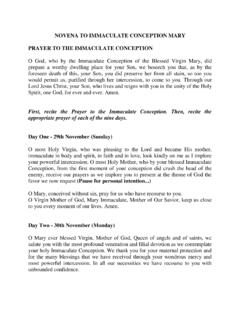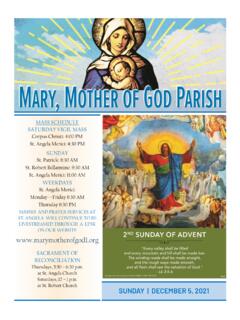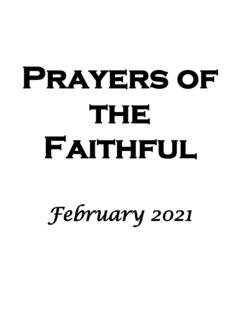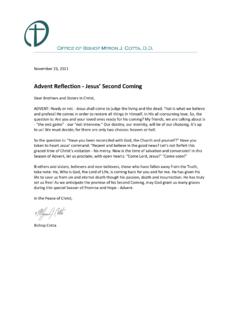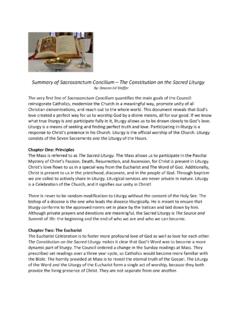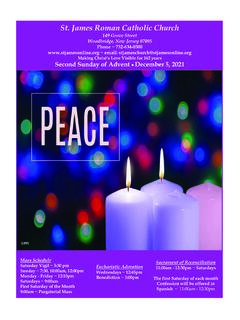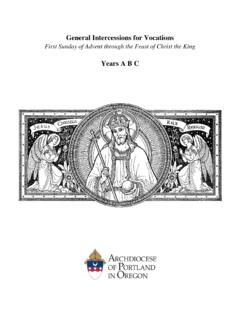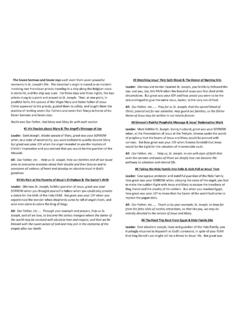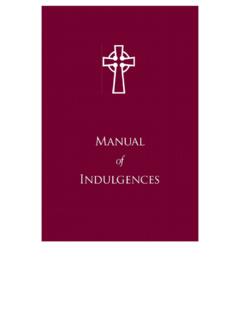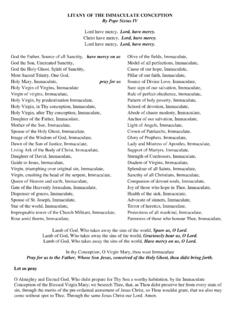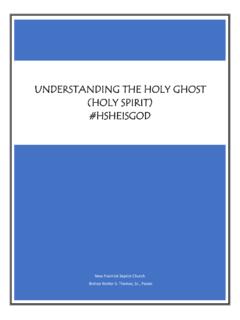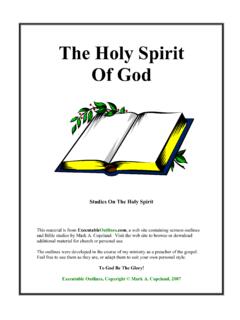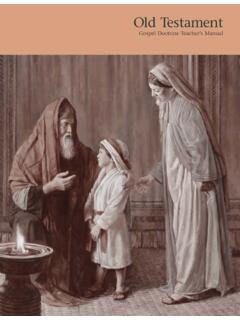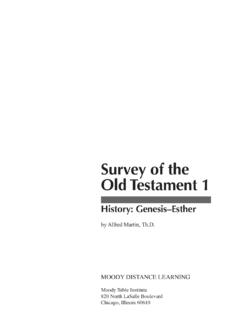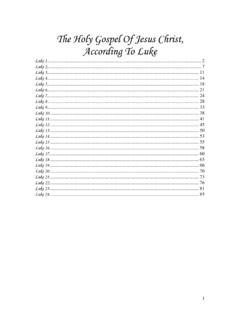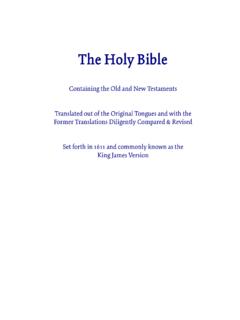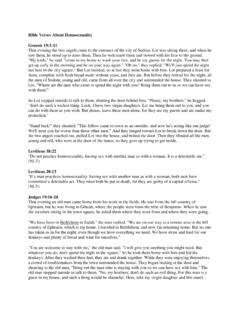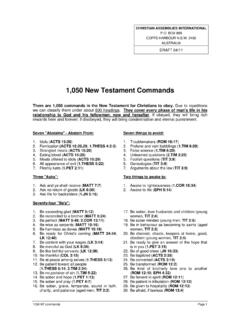Transcription of Explanation of Andrei Rublev's Icon of the Trinity
1 Explanation of Andrei Rublev's Icon of the Trinity Andrei Rublev was born circa 1360. Little is known of his early life however, his name is associated with the history of the Moscow artistic school. Many of his works, just as those of his disciples and followers, originated in Moscow or in towns and monasteries around it. His works can be viewed in both the Tretyakov Gallery in Moscow and the Russian Museum in St. Petersburg. He died on January 29, 1430 and is buried at the Andronikov Monastery in Moscow. About Icons. An icon is not a painting in the sense we normally regard pieces of art, although it is an image that is painted. An icon is a window out of the obvious realities of everyday life into the realm of God. Every paint-stroke has a meaning hallowed by centuries of prayer. Icons are religious images that hover between two worlds, putting into colors and shapes what cannot be grasped by the intellect.
2 Rendering the invisible visible. Icons are the visual equivalents of the Divine Scriptures. Not every religious painting can be considered an icon. Icons are religious pictures that convey inner spiritual meaning of their subject matter. The Son of God came to restore the divine image in human form. Iconography is the graphic witness to this restoration. Restoration of the Trinity Icon. In the medieval Russia, all newly painted icons were coated with a layer of a special drying oil to protect the painting against mechanical damage and to impart greater intensity to the colors. Unfortunately, with the passing of time the Icon became oil darkened, thereby obscuring the original colors and eventually turning it completely black. For this reason, the icon had to be restored. The Trinity was painted over with fresh paints within its faintly discernible contours. This procedure was repeated several times. Towards the turn of the twentieth century nothing remained of Rublev's masterpiece apart from the rapturous recollections of antiquity.
3 The first attempt to remove later accretions from the fifteenth-century icon was made in 1905. At the end of 1918 restoration work was continued, the surround was removed and it is only since then that the icon's appearance has become close to the original. The words "close to" are used because, after five centuries, the icon's painting turned out to be severely damaged. The gold background was lost, the tree was painted anew within the old contours and the top layers of paint were washed off. Even the ground was partially disturbed and cracks appeared, the outlines of the Angels' heads were partly altered. Notwithstanding the above, even in its present state the Trinity remains one of the best of all the Russian icons. According to the theological interpretations whose authors associated the Old testament events with events of the New testament , these Angels were the three Persons of the Trinity : God the Father, God the Son and the holy spirit .
4 Though revealing direct iconographic affinity with this kind of representations, the Trinity as painted by Rublev, has its own features that carry a new quality and a new content. In Rublev's icon we observe for the first time all the three Angels shown equal. This icon alone conformed to the strict rules of the orthodox doctrine of the Trinity . It is not fortuitous that we perceive Andrei Rublev's Trinity as the highest achievement of Russian art. Crowning a long artistic career of a single master, it is also an embodiment of the creative thought of several generations. Just as any other medieval artist, Rublev highly valued tradition and collective effort Explanation of the meaning on the Trinity Icon. This icon takes as its subject the mysterious story where Abraham receives three visitors as he camps by the oak of Mamre. He serves them a meal. As the conversation progresses he seems to be talking straight to God, as if these 'angels' were in some way a metaphor for the three persons of the Trinity .
5 In Rublev's representation of the scene, the three gold-winged figures are seated around a white table on which a golden, chalice-like bowl contains a roasted lamb. In the background of the picture, a house can be seen at the top left and a tree in the center. Less distinctly, a rocky hill lies in the upper right corner. The composition is a great circle around the table, focusing the attention on the chalice-bowl at the center, which reminds the viewer inescapably of an altar at Communion. On one level this picture shows three angels seated under Abraham's tree, but on another it is a visual expression of what the Trinity means, what is the nature of God, and how we approach him. Reading the picture from left to right, we see the Father, the Son, and the holy spirit . The Colors Rublev gives each person of the Trinity different clothing. On the right, the holy spirit has a garment of the clear blue of the sky, wrapped over with a robe of a fragile green.
6 So the spirit of creation moves in sky and water, breathes in heaven and earth. All living things owe their freshness to his touch. The Son has the deepest colors; a thick heavy garment of the reddish-brown of earth and a cloak of the blue of heaven. In his person he unites heaven and earth, the two natures are present in him, and over his right shoulder (the Government shall be upon his shoulder) there is a band of gold shot through the earthly garment, as his divinity suffuses and transfigures his earthly being. The Father seems to wear all the colors in a kind of fabric that changes with the light, that seems transparent, that cannot be described or confined in words. And this is how it should be. No one has seen the Father, but the vision of him fills the universe. The wings of the angels or persons are gold. Their seats are gold. The chalice in the center is gold, and the roof of the house. Whether they sit, whether they fly, all is perfect, precious, and worthy.
7 In stasis, when there is no activity apparent on the part of God, his way is golden. When he flies, blazes with power and unstoppable strength, his way is golden. And in the Sacrifice at the center of all things, his way is golden. The light that shines around their heads is white, pure light. Gold is not enough to express the glory of God. Only light will do, and that same white becomes the holy table, the place of offering. God is revealed and disclosed here, at the heart, in the whiteness of untouchable light. The Father looks forward, raising his hand in blessing to the Son. It is impossible to tell whether he looks up at the Son or down to the chalice on the table, but his gesture expresses a movement towards the Son. This is my Son, listen to The hand of the Son points on, around the circle, to the spirit . In this simple array we see the movement of life towards us, The Father sends the Son, the Son sends the spirit .
8 The life flows clockwise around the circle. And we complete the circle. As the Father sends the Son, as the Son sends the holy spirit , so we are invited and sent to complete the circle of the Godhead with our response. And we respond to the movement of the spirit who points us to Jesus. And he shows us the Father in whom all things come to fruition. This is the counter-clockwise movement of our lives, in response to the movement of God. And along the way are the three signs at the top of the picture, the hill, the tree, and the house. The spirit touches us, even though we do not know who it is that is touching us. He leads us by ways we may not be aware of, up the hill of prayer. It may be steep and rocky, but the journeying God goes before us along the path. It leads to Jesus, the Son of God, and it leads to a tree. A great tree in the heat of the day spreads its shade. It is a place of security, a place of peace, a place where we begin to find out the possibilities of who we can be.
9 It is no ordinary tree. It stands above the Son in the picture, and stands above the altar-table where the lamb lies within the chalice. Because of the sacrifice this tree grows. The tree of death has been transformed into a tree of life for us. The tree is on the way to the house. Over the head of the Father is the house of the Father. It is the goal of our journey. It is the beginning and end of our lives. Its roof is golden. Its door is always open for the traveler. It has a tower, and its window is always open so that the Father can incessantly scan the roads for a glimpse of a returning prodigal. Staffs for the journey Each person holds a staff, which is so long it, cuts the picture into sections. Why should beings with wings, that can fly like the light, have need of a staff for their journey? Because we are on a journey and these three persons enter into our journey, our slow movement across the face of the earth.
10 Their feet are tired from traveling. God is with us in the weariness of our human road. The traveler God sits down at our ordinary tables and spreads them with a hint of heaven. The Table The table or altar lies at the center of the picture. It is at once the place of Abraham's hospitality to the angels, and God's place of hospitality to us. That ambiguity lies at the heart of communion, at the heart of worship. As soon as we open a sacred place for God to enter, for God to be welcomed and adored, it becomes his place. It is we who are welcomed, it is we who must 'take off our shoes' because of the holiness of the ground. Contained in the center of the circle, a sign of death. The lamb, killed. The holy meal brought to the table. All points to this space, this mystery: within it, everything about God is summed up and expressed, his power, his glory, and above all his love. And it is expressed in such a way that we can reach it.
